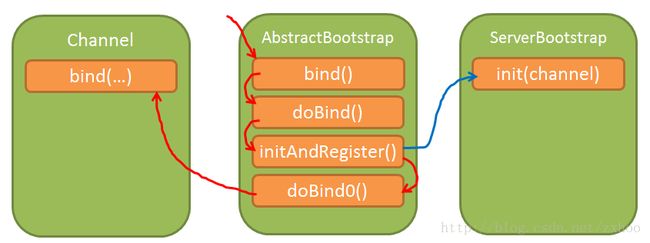Netty4学习笔记(3)-- ServerBootstrap
这篇文章接着上一篇,分析一下Netty4的ServerBootstrp是如何工作的。
EchoServer
先看看Netty自带的EchoServer例子:
/**
* Echoes back any received data from a client.
*/
public class EchoServer {
private final int port;
public EchoServer(int port) {
this.port = port;
}
public void run() throws Exception {
// Configure the server.
EventLoopGroup bossGroup = new NioEventLoopGroup();
EventLoopGroup workerGroup = new NioEventLoopGroup();
try {
ServerBootstrap b = new ServerBootstrap();
b.group(bossGroup, workerGroup)
.channel(NioServerSocketChannel.class)
.option(ChannelOption.SO_BACKLOG, 100)
.handler(new LoggingHandler(LogLevel.INFO))
.childHandler(new ChannelInitializer<SocketChannel>() {
@Override
public void initChannel(SocketChannel ch) throws Exception {
ch.pipeline().addLast(
//new LoggingHandler(LogLevel.INFO),
new EchoServerHandler());
}
});
// Start the server.
ChannelFuture f = b.bind(port).sync();
// Wait until the server socket is closed.
f.channel().closeFuture().sync();
} finally {
// Shut down all event loops to terminate all threads.
bossGroup.shutdownGracefully();
workerGroup.shutdownGracefully();
}
}
public static void main(String[] args) throws Exception {
int port;
if (args.length > 0) {
port = Integer.parseInt(args[0]);
} else {
port = 8080;
}
new EchoServer(port).run();
}
}
可以看出,用法和Bootstrap差不多。
作为Builder的ServerBootstrap
public final class ServerBootstrap extends AbstractBootstrap<ServerBootstrap, ServerChannel> {
private final Map<ChannelOption<?>, Object> childOptions = new LinkedHashMap<ChannelOption<?>, Object>();
private final Map<AttributeKey<?>, Object> childAttrs = new LinkedHashMap<AttributeKey<?>, Object>();
private volatile EventLoopGroup childGroup;
private volatile ChannelHandler childHandler;
// ...
}
看代码可以知道,ServerBootstrap比它的超类多了四个Part,如下图所示:
从bind()方法入手
bind()方法实际上是在AbstractBootstrap里定义的,bind()先调用validate()方法检查各个Part是否准备就绪,然后把工作交给了doBind()方法。doBind()方法首先调用initAndRegister()方法,然后把工作交给doBind0()。initAndRegister()会调用模板方法init()来初始化Channel,initAndRegister()方法的细节上篇文章分析过了,这里不再复述。下面是整个方法调用过程的示意图:
init()方法
@Override
void init(Channel channel) throws Exception {
final Map<ChannelOption<?>, Object> options = options();
synchronized (options) {
channel.config().setOptions(options);
}
final Map<AttributeKey<?>, Object> attrs = attrs();
synchronized (attrs) {
for (Entry<AttributeKey<?>, Object> e: attrs.entrySet()) {
@SuppressWarnings("unchecked")
AttributeKey<Object> key = (AttributeKey<Object>) e.getKey();
channel.attr(key).set(e.getValue());
}
}
ChannelPipeline p = channel.pipeline();
if (handler() != null) {
p.addLast(handler());
}
final EventLoopGroup currentChildGroup = childGroup;
final ChannelHandler currentChildHandler = childHandler;
final Entry<ChannelOption<?>, Object>[] currentChildOptions;
final Entry<AttributeKey<?>, Object>[] currentChildAttrs;
synchronized (childOptions) {
currentChildOptions = childOptions.entrySet().toArray(newOptionArray(childOptions.size()));
}
synchronized (childAttrs) {
currentChildAttrs = childAttrs.entrySet().toArray(newAttrArray(childAttrs.size()));
}
p.addLast(new ChannelInitializer<Channel>() {
@Override
public void initChannel(Channel ch) throws Exception {
ch.pipeline().addLast(new ServerBootstrapAcceptor(
currentChildGroup, currentChildHandler, currentChildOptions, currentChildAttrs));
}
});
}
ServerBootstrap类的init()方法虽然很长,但是却不难理解。首先是给Channel设置options和attrs,然后把User提供的针对NioServerSocketChannel的Handler添加到Pipeline的末尾。接下来复制childOptions和childAttrs,最后实例化一个ChannelInitializer,添加到Pipeline的末尾。init()方法执行完毕之后,AbstractBootstrap的initAndRegister()方法会将NioServerSocketChannel注册到group里。到此为止,NioServerSocketChannel的状态如下图所示:
ChannelInitializer在channelRegistered事件触发后会调用initChannel()方法,随后把自己从Pipeline里删除:
@Sharable
public abstract class ChannelInitializer<C extends Channel> extends ChannelInboundHandlerAdapter {
private static final InternalLogger logger = InternalLoggerFactory.getInstance(ChannelInitializer.class);
/**
* This method will be called once the {@link Channel} was registered. After the method returns this instance
* will be removed from the {@link ChannelPipeline} of the {@link Channel}.
*
* @param ch the {@link Channel} which was registered.
* @throws Exception is thrown if an error occurs. In that case the {@link Channel} will be closed.
*/
protected abstract void initChannel(C ch) throws Exception;
@SuppressWarnings("unchecked")
@Override
public final void channelRegistered(ChannelHandlerContext ctx)
throws Exception {
boolean removed = false;
boolean success = false;
try {
initChannel((C) ctx.channel());
ctx.pipeline().remove(this);
removed = true;
ctx.fireChannelRegistered();
success = true;
} catch (Throwable t) {
logger.warn("Failed to initialize a channel. Closing: " + ctx.channel(), t);
} finally {
if (!removed) {
ctx.pipeline().remove(this);
}
if (!success) {
ctx.close();
}
}
}
}
所以注册之后的NioServerSocketChannel状态如下图所示:
ServerBootstrapAcceptor
private static class ServerBootstrapAcceptor extends ChannelInboundHandlerAdapter {
private final EventLoopGroup childGroup;
private final ChannelHandler childHandler;
private final Entry<ChannelOption<?>, Object>[] childOptions;
private final Entry<AttributeKey<?>, Object>[] childAttrs;
@SuppressWarnings("unchecked")
ServerBootstrapAcceptor(
EventLoopGroup childGroup, ChannelHandler childHandler,
Entry<ChannelOption<?>, Object>[] childOptions, Entry<AttributeKey<?>, Object>[] childAttrs) {
this.childGroup = childGroup;
this.childHandler = childHandler;
this.childOptions = childOptions;
this.childAttrs = childAttrs;
}
@Override
@SuppressWarnings("unchecked")
public void channelRead(ChannelHandlerContext ctx, Object msg) {
Channel child = (Channel) msg;
child.pipeline().addLast(childHandler);
for (Entry<ChannelOption<?>, Object> e: childOptions) {
try {
if (!child.config().setOption((ChannelOption<Object>) e.getKey(), e.getValue())) {
logger.warn("Unknown channel option: " + e);
}
} catch (Throwable t) {
logger.warn("Failed to set a channel option: " + child, t);
}
}
for (Entry<AttributeKey<?>, Object> e: childAttrs) {
child.attr((AttributeKey<Object>) e.getKey()).set(e.getValue());
}
try {
childGroup.register(child);
} catch (Throwable t) {
child.unsafe().closeForcibly();
logger.warn("Failed to register an accepted channel: " + child, t);
}
}
// ...
}
ServerBootstrapAcceptor在channelRead事件触发的时候(也就有客户端连接的时候),把childHandler加到childChannel Pipeline的末尾,设置childHandler的options和attrs,最后把childHandler注册进childGroup,如下图所示:




